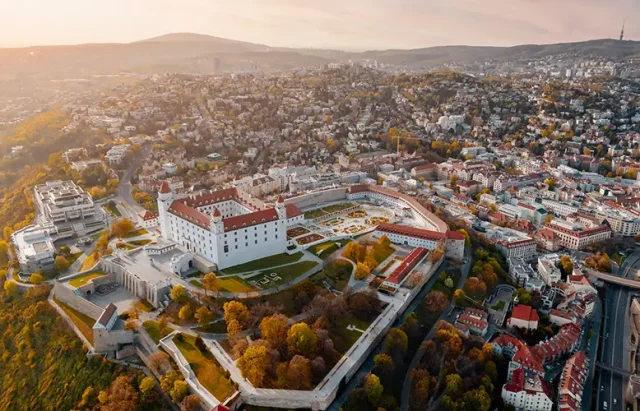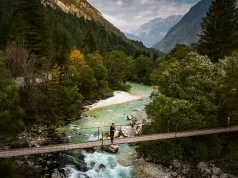
A Glimpse of Slovakia’s Past
Slovakia has been a crossroads of civilizations. Ruled by the Romans, followed by the Slavs in the 6th century, and many more after. Other empires to oversee its territory include the Great Moravian Empire, the Kingdom of Hungary, and the Austrian Empire.
In 1918 Slovakia became part of Czechoslovakia. It wasn’t until January 1st 1993 that Slovakia became an independent nation.
Joining the European Union in 2004 and the Schengen Zone in 2007, Slovakia has flourished since. As an EU member and a Schengen country, Slovakia shares external borders with its fellow member states.
Off the Beaten Path: Slovakia’s Hidden Treasures
1. Spiš Castle and Levoča. Spiš Castle ” is one of the largest ensembles of 13th and 14th military, political and religious buildings in Central Europe”. It offers a glimpse into medieval grandeur. The impressive castle is set in the historic town centre of Levoča. It’s wonderfully well-preserved. You can visit the 14th-century church of St. James.
How to Get There: Accessible by train or bus from major cities like Bratislava or Košice.
Where to Stay: Choose from quaint guest houses in Levoča for an authentic experience.
2. Slovak Paradise National Park. Slovensky raj is home to forests, meadows, canyons, underground caves, and waterfalls. There are over 300 km (over 180 miles) of marked trails for visitors. The difficulty of the trails varies, but most are not too challenging. The most popular trails and tourist points include:
- Prielom Hornadu
- Klastorsko (which features Cathusian monastery ruins)
- Sokolia Dolina
- Kysel
- Piecky
Getting There: A short drive or bus ride from Poprad.
Accommodations: Stay in nearby Hrabušice for easy park access.
3. Bardejov is a UNESCO World Heritage Site. It is a beautiful medieval town, that has survived the test of time. Its history dates back to the 13th century. Its location on a major trade route across the Carpathian Mountains made it an important trading town.
15th-century burgher’s houses and a Gothic Basilica make up the town center. The Jewish quarter includes a synagogue and 18th-century historical buildings. The entire historic core was declared a Town Conservation Reserve in 1950.
Travel Tips: Reachable by train or bus from major cities.
Stay: Opt for historic hotels or cozy B&Bs in the town center.
Slovakia’s Star Attractions: Why They Shine
1. Bratislava is the capital city. Known for its lively bars, historic architecture, and the impressive Bratislava Castle. It’s an ideal way to experience Slovakian culture, art, food, and nightlife.
When you visit, a stroll through the Old Town is a must. It features charming streets, cafes, and restaurants.
Take a boat ride along the Danube River or a trip to Devin Castle, just outside the city.
If you are passionate about history, the Museum of Jewish Culture or the Museum of Trade are great choices. The latter offers insights into the city’s trading history.
Interesting fact: Vienna and Bratislava are only 60 km from each other.
Popularity: Its vibrant culture and exciting nightlife.
Stay: Choose from luxury hotels to budget-friendly hostels.
2. High Tatras is a mountain range that boasts striking landscapes. The majestic peaks, deep valleys, and crystal-clear mountain lakes are a magnet for nature lovers.
There are countless outdoor activities to do in High Tatras. During your visit and depending on the season, you can hike, snowboard, ski, climb, or mountain bike.
Photographers are also drawn to High Tatras. The incredible landscapes make for stunning images.
As a visitor, you will find diverse flora and fauna. You might spot rare species such as the Tatra chamois, or marmots.
The region is also known for its spa towns. Tatranská Lomnica and Štrbské Pleso, for instance, offer thermal baths and wellness treatments.
Why Visit: The breathtaking scenery and outdoor activities.
Accommodations: Mountain resorts and lodges are plentiful.
Traveling in Slovakia: Ease and Affordability
Slovakia is affordable, offering great value for money. Dining, accommodation, and transportation are generally cheaper than in Western Europe.
Culinary Delights: A Taste of Slovakia
Don’t miss trying Bryndzové Halušky (potato dumplings with sheep cheese). At times, the dish comes with sprinkles of cooked bits of smoked pork or bacon, chives or spring onions. It’s an ideal dish for a cold day. Get a Kofola, a local soft drink, to go along with your meal and enjoy!
Be sure to try Slovak wines, especially those from the Tokaj region. We know little about them overseas, but you won’t regret a Slovak wine tasting.
Getting Around: Seamless Connections
Public transport in Slovakia is efficient and affordable. Trains and buses connect major cities and towns. Get your tickets online, at stations, or while getting on the bus.
Renting a car offers more flexibility for exploring remote areas
Tips for U.S. Travelers
- You don’t need a visa for stays under 90 days. In 2025, you will need to register online to get ETIAS, the electronic travel authorization.
- Most people in tourist areas in Slovakia speak English. But, learning a few Slovak phrases makes a difference. “Dobrý deň” (Good day) and “Ďakujem” (Thank you) can go a long way in showing respect for the local culture. Use your smartphone to help you translate.
- Slovakia uses the Euro, so there is no need for currency conversions within the Eurozone.
- In Slovakia, tipping is customary. A tip of around 10% in restaurants and for taxi services is appreciated, though not mandatory.
- Slovaks are proud of their heritage. Asking about their history, folklore, and traditions is a great way to connect with them.
- Slovakia has a high standard of healthcare. We recommend having travel insurance that covers medical expenses. EU health regulations are in place, ensuring a high level of hygiene and safety standards.
- There is excellent mobile coverage. you can either use international roaming or buy a local SIM card for better rates.
- Free Wi-Fi is available in hotels, cafés, and public areas, making it easy to stay connected.





